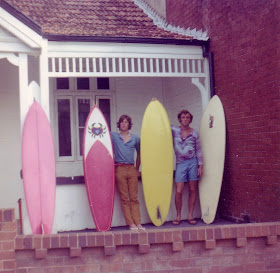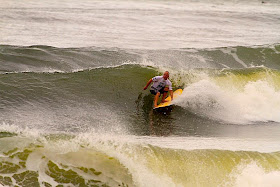Although its not a UK board, this is in my eyes a stunner, which has been over here since 1968 or '69. Made by Klemm Bell in Victoria, Australia, probably in early 1968 its a great example of a transitional v-bottom pig - nicknamed a Stubbie in Oz - a short lived design in the evolution from longboards to shortboards in the late 60s. It was surfed around Newquay in 1969 and '70 as the registration stickers show. It has longboard style rail laps and a square of extra cloth on the deck for knee paddling. Dimensions are 8'3 x 23ins x 3 ins thick, mabye a bit more on the deep v, and a lot less on the slim rails.
Its also a very interesting board because it is a near copy of the board local Victoria surfer and 'Golden child' Wayne Lynch was making and riding at the time, and famously rode in Paul Witzig's film Evolution. Wayne rode the board in France during filming in '68 in memorable scenes at Le Barre and other French spots, with mindblowing style and moves , revolutionising backhand surfing , taking switchstance barrels, roundhouse cutbacks -check out Evolution some time.
Wayne did actually shape for Klemm Bell in 1971. Whether he actually shaped this is a long shot as its not signed ; but its definitely linked shape wise, and with the double logo which Lynch put on his board, thick black outline on the underside, and long raked flexfin (14 inches high !). The board is stringerless, but has a tartan ribbon under the glassing on the underside.
Wayne rides at least seven different boards in Evolution, which shows the fast pace boards were being experimented with. By 1969 the v bottom was history. Tony Cope wrote on seeing the board - ''the sister to the board Wayne Lynch had in France in 1968 and appears in Evolution ......Wayne from Lorne, Victoria of course ( same area as Klemm Bell) . The same board we copied at Westcoast (in Woolacombe) and went just great in GB slop due to its shape/width. THE board to have until Keith Paull came across with his Bing foil.''
''The Lynchy Evolution board was a Wayne Lynch Involvment model by John Arnold surfboards in South Australia. Wayne had a close association with John Arnold in the late 60s. Like many surf crew in Torquay Wayne's earliest shaping efforts were at Fred Pyke's factory in Boston Road, Torquay. Wayne's first shaping effort carried a Pyke logo and some pretty trippy artwork by Simon Buttenshaw. In 1970 Wayne started riding some Pat Morgan keel finned boards as well as continung to refine his own shaping skills.'' Craig Baird, curator, Surfworld Museum, Torquay, Aus.
The previous owner of the board was Brett, who was given it around 25 years ago by a friend in London. This friend was originally given it as a birthday present from his girlfriend but being based in London he only ever used it a couple of times.
Wayne Lynch Evolution board recent recreation, shaped by Wayne in limited numbers.
The important things in life - paisley v-bottoms and Holden surfwagons. Ad from the 1968 Bell's comp. programme, sent in by Craig Baird.
The factory was run by Terry Klemm and Reg Bell, Williamstown Victoria until the factory burnt down in 1967, and relocated to Gardenvale, Melbourne. This board has Williamstown on the logo so it could have been made late'67 or mabye it was an old logo used in 68.Extreme Greenough 14 inch flex fin next to an fcs fin for scale ! The fin flexes easily by hand, and was designed to bend going into a turn and spring back to power you out of the turn. The harder the turn the more stress fractures appeared on your fin..
v-bottom, originally designed by Bob McTavish and took the surfing world by storm - for about a year ! Went well in small to medium waves, struggled in Hawaii.
Chris Ash's Westcoast Wayne Lynch copy. Again a pig shape with wide tail, raked fin and thick black pinlines.
Tony at Boscombe pier on his Wayne Lynch copy . As Tony says of this and Chris Ash's Westcoast compared with WL- ''All same shape boards, but surf & surfers at opposite poles !''



.jpg)






.jpg)



.jpg)
.jpg)
.jpg)














.jpg)
.jpg)
.jpg)
.jpg)

.jpg)
.jpg)
.jpg)


















